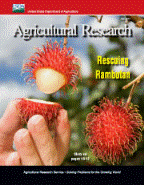United States Department of Agriculture: Agricultural Research Service, Lincoln, Nebraska

Agricultural Research Magazine
Date of this Version
3-2013
Document Type
Article
Citation
Agricultural Research March 2013
Abstract
Manure spills happen for a range of reasons—a manure spreader rolls over, a hose breaks, a storage pond overflows after a relentless downpour. Whatever the cause, these events are such a threat to the environment that states have emergency teams to deal with the hazard.
Typically, the responders build dams to contain the spill and then pump out the contaminated water. Although cleanup efforts start as quickly as possible, a fish kill in a nearby stream is often the first evidence that a spill has taken place.
Another problem is that sediments in the contaminated water channel can capture phosphorus from the manure and release the nutrient back into the water— sometimes for months on end—at levels exceeding U.S. Environmental Protection Agency (EPA) criteria. But there were few details available about the links between manure spills and phosphorus until Agricultural Research Service soil scientist Doug Smith and doctoral candidate Shalamar Armstrong began to study the issue.
Smith, who works at the ARS National Soil Erosion Research Laboratory in West Lafayette, Indiana, was Armstrong’s technical advisor throughout the study. ARS soil scientist Chi-hua Huang, also in West Lafayette, and soil scientist April Leytem, who works at the ARS Northwest Irrigation and Soils Research Laboratory in Kimberly, Idaho, were also part of the team.
Included in
Agriculture Commons, Animal Sciences Commons, Food Science Commons, Plant Sciences Commons

